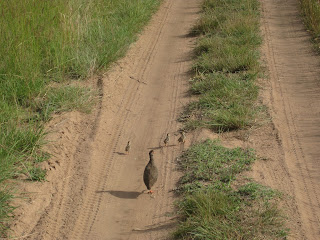I had a great time at the nature parks and reserves in Africa. Initially, I thought I would be bored by Day 2 of a 6-day safari, seeing the same animals again and again. Sure, the baboons do not rate any more after the first day but it was AMAZING watching the animals in their natural habitat, oblivious to us, humans, the invaders, our presence. The behaviours of some of the animals differ from place to place too. There is always something interesting and fascinating.
What have the animals taught me?
For one, do not be narrow-minded and run in one direction mindlessly like a zebra or a wildebeest. For some reasons, zebras and wildebeests do not turn left or right when followed by a vehicle. It was really funny watching them run frantically forward when we followed behind slowly (yes, it is really mean of me). In life, I guess we have to learn how to change direction once in a while or turn around and confront. Time for me to pick up boxing. Dodge left. Duck right.
 |
| Run, baby, run |
From the topi, I learn that vigilance is all it takes when you are alone. The topi, facing 2 lions, only had to show them that it knew of their presence. It did not even have to run (although it does help to have horns). The lions just went away. Great tip for the lone traveller to deter potential attackers.
 |
| Red alert |
What are my favourite animals from the safari?
Favourite
bird: A nameless bird (maybe it was a
comec, I am not sure). It is small. Instead of flapping its wings, it
skipped a little and propelled itself upwards in a trajectory motion
with the aid of the wind. Very “Angry Bird” like. Too cute.
Favourite
animal: The male lion for being sweet
Tips and considerations for safaris
1. Enquire the qualification of the guide. Experience on the field matters. There are professional examinations for guides who went through courses on the geography, flora and fauna of the reserves.
2. Ask about the mode of transport. Open-top 4X4 are better vehicles in the reserves. It is also better to have radios on car because guides do share notes (such as where a leopard has been spotted) on the air.
3. If you have a favourite or just want to concentrate on certain animals, let your guide know so that he can focus on those animals (be it asking fellow guides/ drivers or bringing your to the usual spots were those animals appear). The parks have opening hours. There is no point driving around the huge parks and pointing out animals you do not want to see.
4. Bring you super gigantic camera lenses. There is no need to be shy about them. Everyone uses them.
 5. Wear
anything you want. Most safari companies would have advised "avoid brightly coloured clothes, they may alarm the animals. Browns, beiges and khaki are preferred." I
think I can understand the wide breamed hat, white shirt and beige
safari pant and the camera man vest (although I do not think that white is very practical, given the dusty roads.)
5. Wear
anything you want. Most safari companies would have advised "avoid brightly coloured clothes, they may alarm the animals. Browns, beiges and khaki are preferred." I
think I can understand the wide breamed hat, white shirt and beige
safari pant and the camera man vest (although I do not think that white is very practical, given the dusty roads.)
What
next? Leopard prints tomorrow? (Or am I being too mean again?)
Honestly, I think the animals will not care if you wear a pink shirt with purple polka
dots and the Kylie Minogue gold hotpants – you will be well hidden
in the vehicle. Why safari companies advise visitors to wear the safari
garb, I do not know. The only place you will get down to walk is
probably in the carpark of the tourist information centre or that of
your hotel. So just wear something comfortable, have something for the cold mornings and get ready for the mosquitoes and insects in the evenings.



Maybe the safari companies also own safari garb business?!?! I guess Kylie Minogue's gold hotpants is fine but surely Lady Gaga's raw beef outfit is out?!?! SJ
ReplyDelete